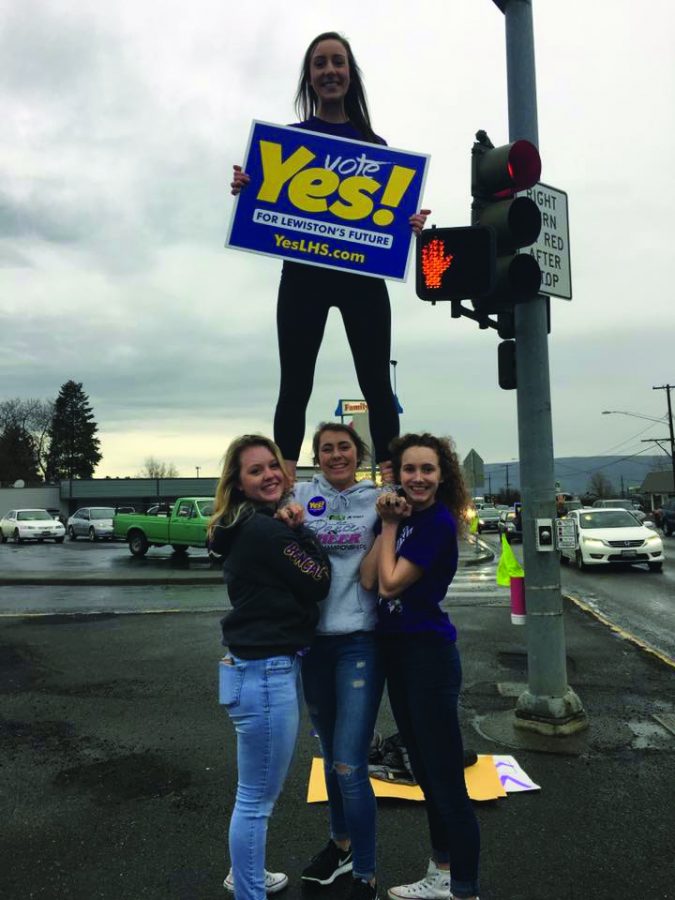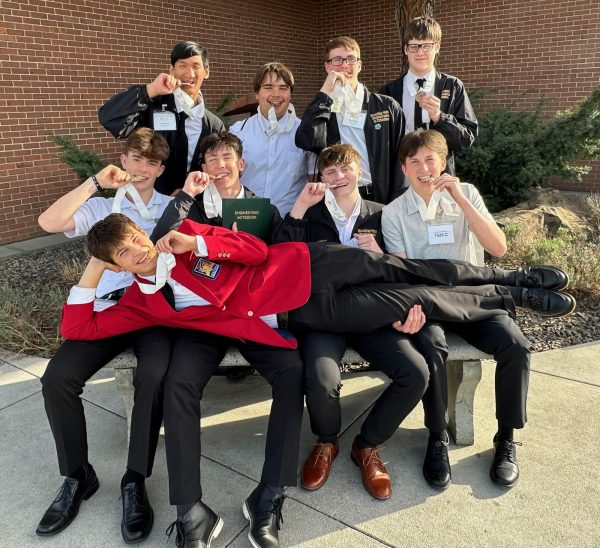Lewiston residents vote to build new school
On March 14 Lewiston School District residents approved a $59.8 million bond for the construction of a new high school. Voters gave a 75.46 percent approval, surpassing, by around 10 percent, the necessary 66.67 percent yes vote required by the state of Idaho.
This is historic due to the age of the current building, established in 1928.
Voting was open 8 a.m. to 8 p.m. and approximately 11,482 ballots were cast — a 66.58 percent voter turnout, according to the Lewiston Tribune. Nez Perce County made absentee voting available Feb. 10 through March 10. And the day of the election Lewiston firefighters offered transportation to voting stations in order to give everyone the opportunity to vote.
Hearing the 10 p.m. announcement that the bond passed March 14, Jesse Maldonado said the experience felt surreal. He worked as the ‘Yes! LHS’ campaign manager and also was a Bengal’s Purr senior editor in 2012-2013.
“If you look at any election — bond, candidate, other issue… getting 55 percent is fantastic but getting 75 is overwhelming,” he said. “It felt like all the hours and energy that everyone poured into the campaign was worth it.”
After the announcement, students from LHS made a visit to post ‘Yes! LHS’ campaign signs in the current high school building around 11 p.m. The students had approval and assistance from administrators.
“We did not have a vandalism [act],” said LHS principal Kevin Driskill. “A few students showed up at LHS with signs excited about the passage of the bond even though they will never experience the school as students. No property damage occurred.”
TRY, TRY, TRY AGAIN
According to Maldonado, one of the largest hurdles for the campaign to overcome was the two-thirds majority vote needed to pass the high school bond.
The second challenge was making sure voters received accurate, correct information, Maldonado said.
”We wanted to make sure people were informed and there were a lot of people trying to make sure people weren’t informed or were misinformed,” he said.
The ‘Yes! LHS’ campaign took lessons from the bonds proposed in 2004 (which lost with a 46.3 percent yes vote), 2010 (lost with a 61.8 percent majority) and 2011 (lost with a 51.6 percent majority).
Mary Ann Funk, the LHS librarian of 29 years, volunteered in all four of the bond campaigns on her own time as a citizen of Lewiston.
“I’ve always served wherever I was asked to help and participate,” Funk said. “I’ ve always believed in the need for a new high school. I just think it was really nice to lend first-hand knowledge to the reality of teaching in this school.”
She explained that the new school is about more than just a building. For her, it’s about community.
“Lewiston really deserves this and if it help keeps my kids living in the valley or anyone else’s, that’s a bonus,” Funk said. “Strong families build strong communities, and strong families value education.”
Kelly Carper, sophomore world history teacher at LHS, used his personal Facebook posts to show his support of the new high school during the most recent campaign.
“I teach social studies and I put citizenship first. If I don’t do that, then I’m not being true to who I am,” said Carper. “The greater message regarding the passage of the bond [is that] the dark banner of ‘good enough’ no longer flies over this city. Achievement, opportunity, growth and improvement are now the new watchwords for education, business and community.”
A DIFFERENT APPROACH
In addition to the ‘Yes! LHS’ campaign, Maldonado also serves as a Lewiston City Council member. He explained that the largest difference about the 2017 campaign was its message.
“We took it to the voters and told them why it was necessary. The reason why it was necessary is the community at large,” Maldonado said. “It wasn’t about a building. It was about the opportunity and promise we can give our kids and the future of the community.”
The Lewiston School Board spent the last five years coming up with what Maldonado described as “a solid, concrete plan for voters to believe in.”
“They handed it to us to sell to the voters and we did,” he said. “But we couldn’t have sold anything if they hadn’t done such a great job.”
The school board’ s efforts focused on keeping jobs local, running studies to show the difference between remodeling and building a new high school, and making a pitch for career technical programs and education by partnering with Lewis-Clark State College.
As campaign manager, Maldonado was in charge of logistics — in charge of making sure all the “wheels were greased” and that the campaign “ran like a well oiled machine,” he said.
There were three co-chairs of the campaign, who were in charge of reaching out to community members for donations and advocating for the passage of the bond. That was Joanna Alford, Nathan Alford and Darin Ball.
‘Yes! LHS’ had more than 300 volunteers — people that knocked on doors, made phone calls to voters, set up for events and waved campaign signs at intersections. Volunteers ranging from preschoolers to elderly voters in their mid-80s made the bond possible.
According to Maldonado, he took zero salary for the campaign, though typically campaign managers are paid. He said the bond election was too important to the community and to him personally for him take money for it.
The campaign budget was $25,000.The campaign raised $36,000, and $40,000 to $50,000 was in donated time or “in kind” from Maldonado, volunteers, ad agencies and media outlets that supported the campaign.
OPPOSITION
Despite its passage, around 24.5 percent of voters still opposed the bond.
Representatives from the main opposition to the bond, Taxpayers Against Unfair Taxation, decided against being interviewed. Leader, David Estes told The Bengal’s Purr, “We are not giving out interviews because that is what the group decided.”
Opponents generally expressed concerns with rising property taxes.
Connor Jensen, LHS senior, voted “no,” though he believes in the need for a new high school.
“There’s only one access point to the school. That will create a bottleneck,” Jensen said. “I really don’t like the property tax but there isn’t anything we can do about that.”





